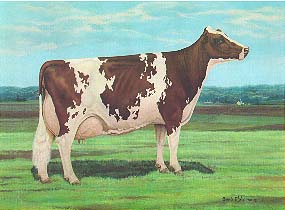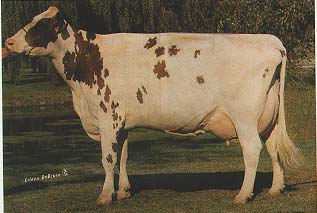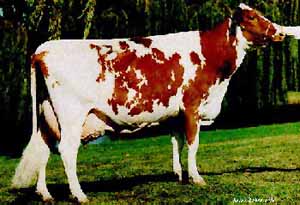
|
Ayrshire
| ||

The Ayrshire breed originated in the County of Ayr in Scotland, prior to 1800. During its development, it was referred to first as the Cunningham, then the Dunlop, and finally, the Ayrshire. Its characteristics gradually became well enough established to consider it a distinct breed, and in 1786, the first Ayrshire show was sponsored by the Highland Agricultural Society.
It is beleived that some strains of cattle from Europe and the Channel Islands were crossed with the native cattle in the early days of the development of the breed, but their influence on the physical appearance and milk producing characteristics of the Ayrshire is not known. Regardless of the details of their origin, the early breeders carefully crossed and selected the various strains of cattle to develop the cow we now know as the Ayrshire. She was well suited for the land and climate in Ayr. She was an efficient grazer, noted for her vigor and efficiency of milk production. She was especially noted for the superior shape and quality o her udder. The composition of her milk made it ideally suited for the production of butter and cheese by the early Scottish dairymen.

Ayrshires are red and white, and purebred Ayrshires only produce red and white offspring. Actually, the red color, is a reddish-brown mahogany that varies in shade from very light to very dark. On some bulls, the mahogany color is so dark that it appears almost black in contrast to the white. There is no discrimination or registry restriction on color patterns for Ayrshires. The color markings vary from nearly all red to nearly all white. The spots are ususally very jagged at the edges and often small and scattered over the entire body of the cow. Usually, the spots are distinct, with a break between the red and the white hair. Some Ayrshires exhibit a speckled pattern of red pigmentation on the skin covered by white hair. Brindle and roan color patterns were once more common in Ayrshires, but these patterns are rare today.
For many years, the Ayrshire horns were a hallmark of the breed. these horns often reached a foot or more in length. They were light colored, except for the dark color on the last few inches of the tips of the horns. When properly trained, they gracefully curved out, and then up and slightly back. When polished for the show ring the Ayrshire horns were a spectacular sight. Unfortunately, the horns were not very practical, and today almos tall Ayshires are dehorned as calves.
Ayrshires are medium-sized cattle and should weight over 1200 pounds at maturity. They are strong, rugged cattle that adapt to all management systems including group handling on dairy farms with free stalls and milking parlors. Ayrshires excel in udder confirmation and are not subject to excessive foot and leg problems. These traits make Ayrshires outstanding commercial diary cattle.
Other traits that make Ayrshires attractive to the commercial dairyman include the vigor of Ayrshire calves. They are stron and easy to raise. Ayrshires do not possess the yellow tallow characteristic that would reduce the carcass value, so Ayrshire bull calves can be profitably raised as steers.
The Ayrshire is a moderate butterfat breed and relatively high protein breed. The average of all Ayrshires on official DHIR test is 15,341 poulds of milk with 00 pounds of fat and 730 pounds of protein. Ayrshires respond to good management and feeding practices and individual Ayrshires have acheived recourds as high as 38,360 pounds in 305 days. Individual herds often produce averages as high as 18,000 pounds of milk, 750 pounds of butter fat and over 700 pounds of protein.
Top producing Ayrshires regularly exceed 20,000 pounds of milk in their lactations. The current world records for an Ayrshire is held by Mini-Ayr Fayre Cav Fayette of Bonfield, Illinois. In 305 days, Fayette produced 38,360 pounds of milk, 1350 pounds o ffat and 1350 pounds of protein. Although the Ayrshire Association does not officially recognize records over 305 days, this same cow also produced 42,320 pounds of milk in 365 days.

The first importations of Ayrshires to the United States was believed to have been made by H.W. Hills, of Windsor, Connecticut, around 1822. Farmers in New England needed a dairy cow that would graze the pastures of their rought, rocky farms and tolerate the cold often inhosptiable winters. In many ways, the environment in New England was very similar to the Ayrshire's native Scotland, and she thrived in her new home. Even today, the Ayrshire is very popular in New England, but her popularity has spread. Ayrshire herds are now located in every part of the United States, including the deep south. The largest numbers of Ayrshires are registered each year in New York, Wisconsin, Pennsylvania, Ohio, Iowa, and Vermont.
During the early part of the twentieth century, Ayrshires were noted for their extremely good type. Old photographs of Ayrshire cattle confirm this fact. To demonstrate their hardiness, the Ayrshire Breeders' Association staged one of the most spectacular promotional events ever conducted by a dairy breed registry association. In 1929, two Ayrshire cows named Tomboy and Alice, were literally walked from the association headquarters in Brandon, Vermont, to the National Dairy Show at St. Louis, Missouri. Both cows not only survived the trip, but calved normally and went on to produce outstanding milk records for their time.
During the twenties and thirties, many Ayrshire herds were established on farms near cities. Some of these farms bottled and distributed their own milk. In the late thirties, the Ayrshire Breeders' Association established the Approved Ayrshire Milk program. The program served the purpose of promoting Ayrshires by promoting their milk. To qualify, a herd had to be comprised entirely of Ayrshires, and the herd owner had to maintain the highest health standards. Promontinal material from the time stated that Ayrshire milk had a better flavor. It also emphasized the unique composition of Ayrshire milk that made it more healthful, especially for children and babies. The promotional literature recommended that mothers give their children Ayrshires milk to be sure they grow to be strong and healthy.
Milk marketing, like herd management, has changed and the Apprived Ayrshire Milk program is no longer in operation. However, it is interesting to note that the promotional themes of the Approved Ayrshire Milk program were very similar to modern milk marketing campaigns. Looking back, their efforts in milk promotion was nearly four decades ahead of its time.
The development of the Ayrshire breed is a story of dedicated people as much as it is a story of great dairy cattle. Farmer breeders, whose livelihood depended on their cattle, along with wealthy hobby farmers and talented and dedicated herd managers all share equal credit for their contributions to the development of the Ayrshire breed. The Ayrshire cow is universally recognized as one of the most beautifulof the dairy cattle breeds, but much more important is the fact that she has been bred and developed to be a useful, profitable commercial dairy cow. With proper feeding and management, the Ayrshire will produce at a profitable level for her owner. By using the modern breed improvement tools of DHI or DHIR testing, type classification, embryo transer, embryo sexing, in-vitro fertilization and artificial insemination, an Ayrshire breed can be sure of breed better Ayrshires to meet th edemands of the modern dairy industry.

In conjuction with the many changes which have taken place during teh late 1980s and early 1990s, the numbers of Ayrshires ( and all other breeds) have decreased. Much of this is due to increased profitability of all dairy cows, which has led to an over-supply of milk to the domestic market. However, careful management has conviced the Ayrshire breeders that their chosen breed has served them well, and will continue to do so in the future.
Recent on-farm experimentation has shown Ayrshires to have been true to their original ancestry: they are efficient grazers. With increased interest in grazing by the dairy industry, the Ayrshire breed association currently receives many calls about the breed's conversion efficiency.
During the continuing restructuring of today's dairy industry, the Ayrshire Association's board is committed to working toward the most important goal: continuing increasing profitability from the Ayrshire breed. The Ayrshire of the future will be better than those of the past. They will milk more and last longer. This is in keeping with the tradition of the Ayrshires breed, and the goals of the Ayrshire breeders who have made the cow what she is today.
